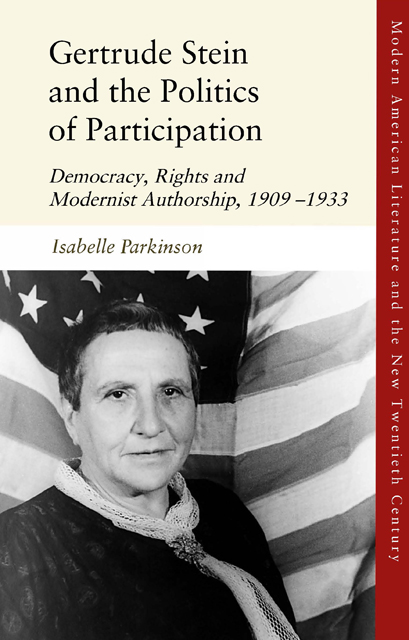 Gertrude Stein and the Politics of Participation
Gertrude Stein and the Politics of Participation Book contents
- Frontmatter
- Contents
- Acknowledgements
- Introduction: Gertrude Stein, Modernism, and Democracy
- Chapter 1 The Politics of Authorship in Three Lives
- Chapter 2 Authorship and Community in Stein’s Pre-war Portraits and Tender Buttons
- Chapter 3 Modernism’s Abject: Geography and Plays and Stein’s Contested Authorship
- Chapter 4 Useful Knowledge and the Mind of Mass Democracy
- Coda: Stein’s Democratic Authorship in The Autobiography of Alice B. Toklas
- Bibliography
- Index
Chapter 2 - Authorship and Community in Stein’s Pre-war Portraits and Tender Buttons
Published online by Cambridge University Press: 25 April 2023
- Frontmatter
- Contents
- Acknowledgements
- Introduction: Gertrude Stein, Modernism, and Democracy
- Chapter 1 The Politics of Authorship in Three Lives
- Chapter 2 Authorship and Community in Stein’s Pre-war Portraits and Tender Buttons
- Chapter 3 Modernism’s Abject: Geography and Plays and Stein’s Contested Authorship
- Chapter 4 Useful Knowledge and the Mind of Mass Democracy
- Coda: Stein’s Democratic Authorship in The Autobiography of Alice B. Toklas
- Bibliography
- Index
Summary
Stein and the New Art
By the 1910s, Stein's break from progressivism and its prose genres seemed complete. The publications of her literary portraits of Matisse and Picasso in 1912 and of Mabel Dodge in 1913, and the appearance of her collection Tender Buttons in 1914, mark her turn away from American realism and its subject matter. In these texts, Stein develops new methods of formal experimentation in which, significantly, the artists around her and the new art they are producing are themselves her subjects. Thus, Stein's exploration of the figure of the artist and the nature of art practice, begun in Three Lives, broadens and deepens in the following decade. Despite her shift in emphasis, however, Stein was still very much attached to a vision of a popular American audience for her work. The portraits of Matisse, Picasso and Dodge were published in the American avant-garde journal, Camera Work, but they were also promoted at the sensational 1913 International Exhibition of Modern Art at the New York Armory. The exhibition attracted huge crowds and its impact was amplified by extravagant responses in the popular press, many of which identified Stein as literary exemplar of the new art. Tender Buttons, published by the private New York press, Claire Marie, caused a second surge of interest and outrage in the mainstream American papers. These publications are Stein's public interventions into what we can now identify as a nascent period in the development of American modernism, and, because of their fevered reception in the mainstream press, both events featured strongly in the public perception of modernism in the US and cemented Stein's reputation as the American author of the new art.
This complex stage of modernism, as it blossomed across a network of centres in European capitals, is marked primarily by a diversity of alternative formulations that attempt to redefine the work of art, both literary and visual. The gathering of writers and artists around new conceptions and theories of art generated the group culture that became a defining feature of the European artistic and literary scene in the 1900s and 1910s.
- Type
- Chapter
- Information
- Gertrude Stein and the Politics of ParticipationDemocracy, Rights and Modernist Authorship, 1909-1933, pp. 84 - 139Publisher: Edinburgh University PressPrint publication year: 2023


